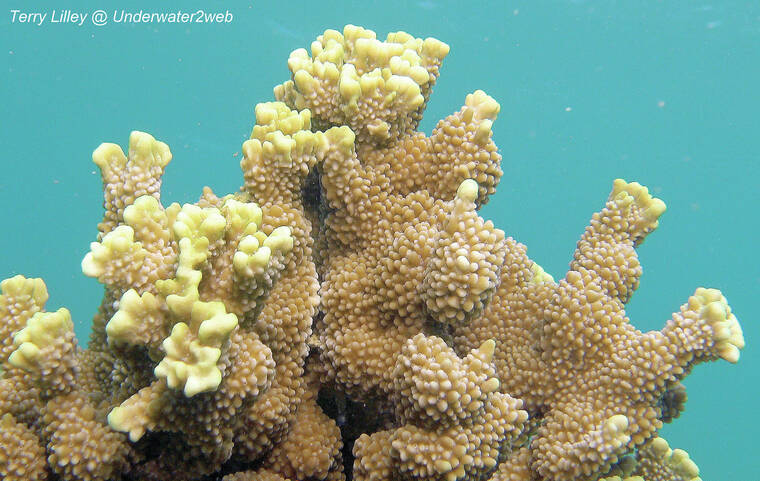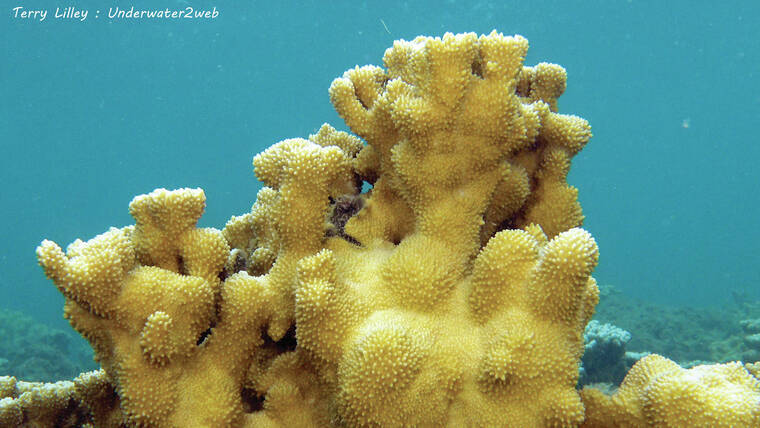In 2012, I shot 100 hours of video of the brown rice corals along the entire Kaua‘i North Shore and was just stunned at the beauty and diversity of this amazing coral species. They are called rice corals because the surface of the coral skeleton looks like grains of rice.
But what is so amazing about the rice coral is how it grows on different parts of the reef. Some brown rice coral grows flat on the reef, of which we call an encrusting coral and other rice corals grow upward and look like tall buildings, of which we call pillar coral. On one reef at ‘Anini Beach I took 7,500 pictures of the rice corals and no two looked alike.
From 2012 to 2014, I shot video of more than 200,000 rice corals from Nualolo to Pila‘a at 60 different dive sites, and these corals were the most common coral species out on the reef. Corals just like humans can get sick and less than 1 percent of the rice corals were diseased at the time, so we gave the reef a clean bill of health.
In late 2014, something changed quickly out on the reef. By 2016, I took another 7,500 pictures and video clips of the rice corals on Kaua‘i’s North Shore and over 80 percent of the ‘ako‘ako‘a were either dead or dying from a cyanobacterial disease. This change was extremely worrisome and I asked UH, NOAA and the USGS to come to Kaua‘i and help me study this new deadly disease killing Kaua‘i corals.
By late 2016, we had done DNA studies on the diseased rice corals along the entire coastline and found out that the corals had a weakened immune system. This was allowing the disease to take hold and wipe out almost the entire colony of rice corals.
We never found out for sure what was causing the rice corals to lose their immune system, but we know it was not do to warming sea temperatures because the waters off North Shore remained cool and the rice corals along the South Shore, where the water was warmer, were not diseased and they were doing just fine.
What we did discover is that the rice coral grows extremely fast. From 2016 to 2022, much of the rice coral had grown back along the entire North Shore and I shot time lapse video of these corals growing over a foot a year. This was truly stunning because we had thought the corals could only grow 1-2 inches a year. What else we discovered is that rice corals can grow in many different shapes and have several different colors.
It was apparent that the rice corals had adapted to a severe environmental problem and had grown back on their own but had changed shape and color. What caused this amazing rebirth of ‘ako‘ako‘a ? We still don’t know for sure but the fastest growth rate of this coral along North Shore happened when the sea temperatures started to rise and corals on other islands were bleaching and dying!
I have now shot video of hundreds of colonies of rice corals at Tunnels Beach, Hanalei and ‘Anini Beach that died, then quickly grew back, got sick again, and then grew back for the second time all within a 10-year period of time. Nowhere else on Earth have we seen a coral reef be healthy, die, become healthy again, die a second time and now they are healthy once again.
Is ‘ako‘ako‘a trying to show us something here? Coral reefs are very complex and we still don’t know how they actually live and relate to all of the rest of the marine life in the sea.
But one thing for sure is these corals taught us is they can adapt and thrive quickly. That may not be directly related to sea temperature rise, sunscreen pollution, tourism, improper coastal development and farm chemical runoff because North Shore rice corals have thrived and regenerated while all of these problems were occurring.
At times we thought the rice corals would die, but they thrived. At other times, we thought they would thrive, but they died and this process was different on other Hawaiian Islands in the same time frame.
We don’t need to study a dying coral reef as much as we need to study and find out how Mother Nature restores her coral reefs all on her own. When a coral reef is healthy, the energy of the surf is broken up by the corals that stick up off of the reef and drag on the underside of the waves causing them to break.
We now know that corals can grow upward faster then the sea levels are rising. When the corals die, the reef lowers and the energy of the surf hits the beach causing massive coastal erosion. The corals are nature’s natural seawall, so we need to know how to keep our coral reefs healthy as that will reduce erosion rates on our beaches.
You can see ‘ako‘ako‘a in action up on my underwater marine life website at underwater2web.com and I will have a new movie out soon showing the life, death and life again of the Kaua‘i rice corals.
•••
Terry Lilley is a marine biologist living in Hanalei Kaua‘i and co-founder of Reef Guardians Hawai‘i, a nonprofit on a mission to provide education and resources to protect the coral reef. To donate to Reef Guardians Hawaii go to www.reefguardianshawaii.org.






